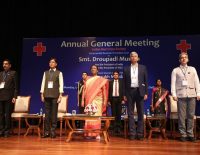Accelerate reach of high-impact tools to prevent malaria: WHO on World Malaria Day

On the occasion of World Malaria Day, the World Health Organisation on Tuesday urged the countries affected by the disease globally to accelerate the reach of high-impact tools and strategies to prevent, detect and treat malaria, with a focus on reaching the most vulnerable, ensuring that no person is left behind.
Dr Poonam Khetrapal Singh, World Health Organisation (WHO) Regional Director for South-East Asia, on the occasion, underlined that because of Covid crisis, the world is not on track to reach the two critical targets of the WHO Global Technical Strategy (GTS) for malaria 2016–2030: reducing global case incidence and mortality by 90% or more by 2030, based on 2015 levels. In 2021, an estimated 619 000 people globally died of malaria compared to 625 000 in 2020. There were an estimated 247 million new cases of malaria, compared to 245 million in 2020.
”The WHO South-East Asia Region continues to lead globally. By the end of 2020, the South-East Asia Region was the only WHO region to achieve a 40% reduction in malaria case incidence and mortality compared to 2015 – the first GTS milestones. Amid the COVID-19 response, Maldives and Sri Lanka have maintained their malaria-free status, and five countries of the Region – Bhutan, DPR Korea, Nepal, Thailand and Timor-Leste – are among 25 countries and one territory globally identified as having the potential to eliminate malaria by 2025”.
On the occasion of World Malaria Day, the WHO called for action in several key areas like strengthening capacity at the sub-national level, with a focus on identifying clear and actionable goals, increasing resource allocations, and empowering local decision-makers. Secondly, shifting power to the peripheries, with a focus on increasing cross-border collaboration, especially in high-burden countries.
Thirdly, the WHO said, ensuring adequate and sustained financing for malaria programmes, recognizing that transitions in funding must be anticipated, planned for and implemented gradually, based on a time-bound strategy. Fourth, transforming surveillance into a core malaria intervention, ensuring that last-mile barriers are identified and overcome. And fifth, accelerating high-impact innovations, not just in diagnostics and treatments, but also in service delivery, in line with the Region’s primary health care approach to achieving universal health coverage – since 2014, one of eight Flagship Priorities in the Region.
Globally, children in the poorest households are five times more likely to be infected with malaria. Malaria is also more prevalent among young children whose mothers have a lower level of education and live in rural areas. Reaching these populations with available malaria prevention, diagnosis and treatment is critical for achieving the Global technical strategy for malaria 2016–2030 and Sustainable Development Goal targets and delivering on the promise of zero malaria for everyone, everywhere.








Comments